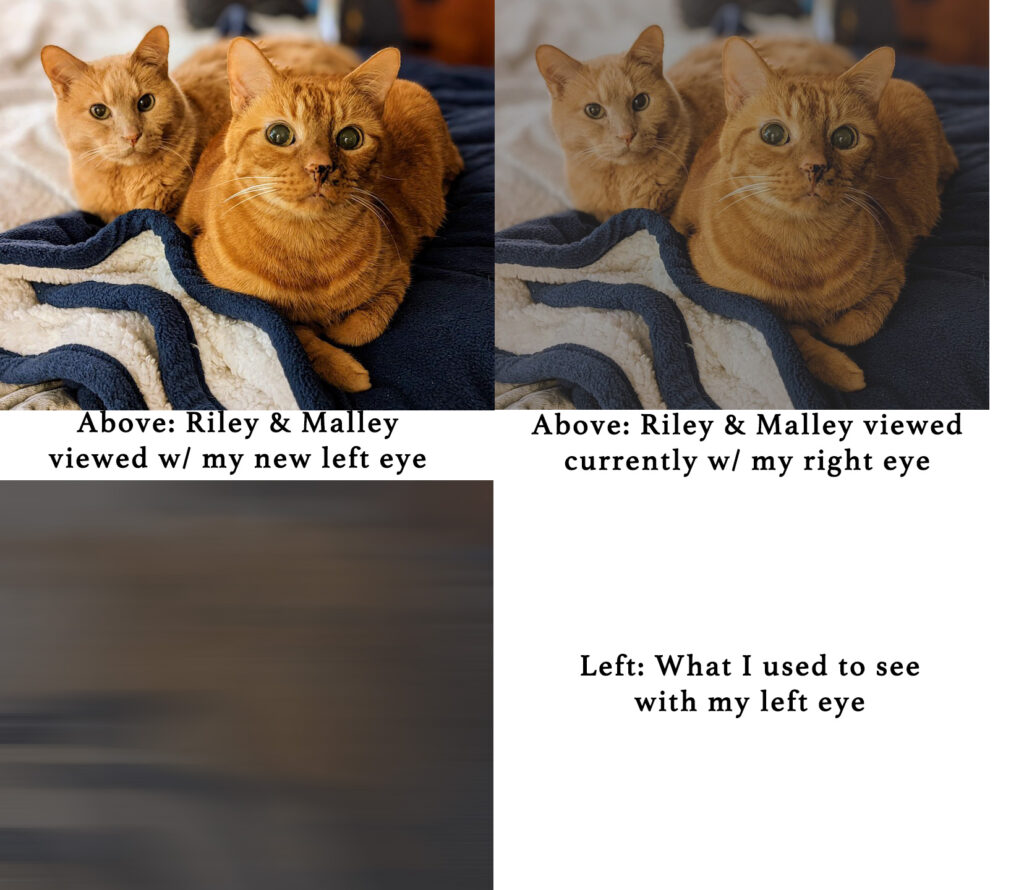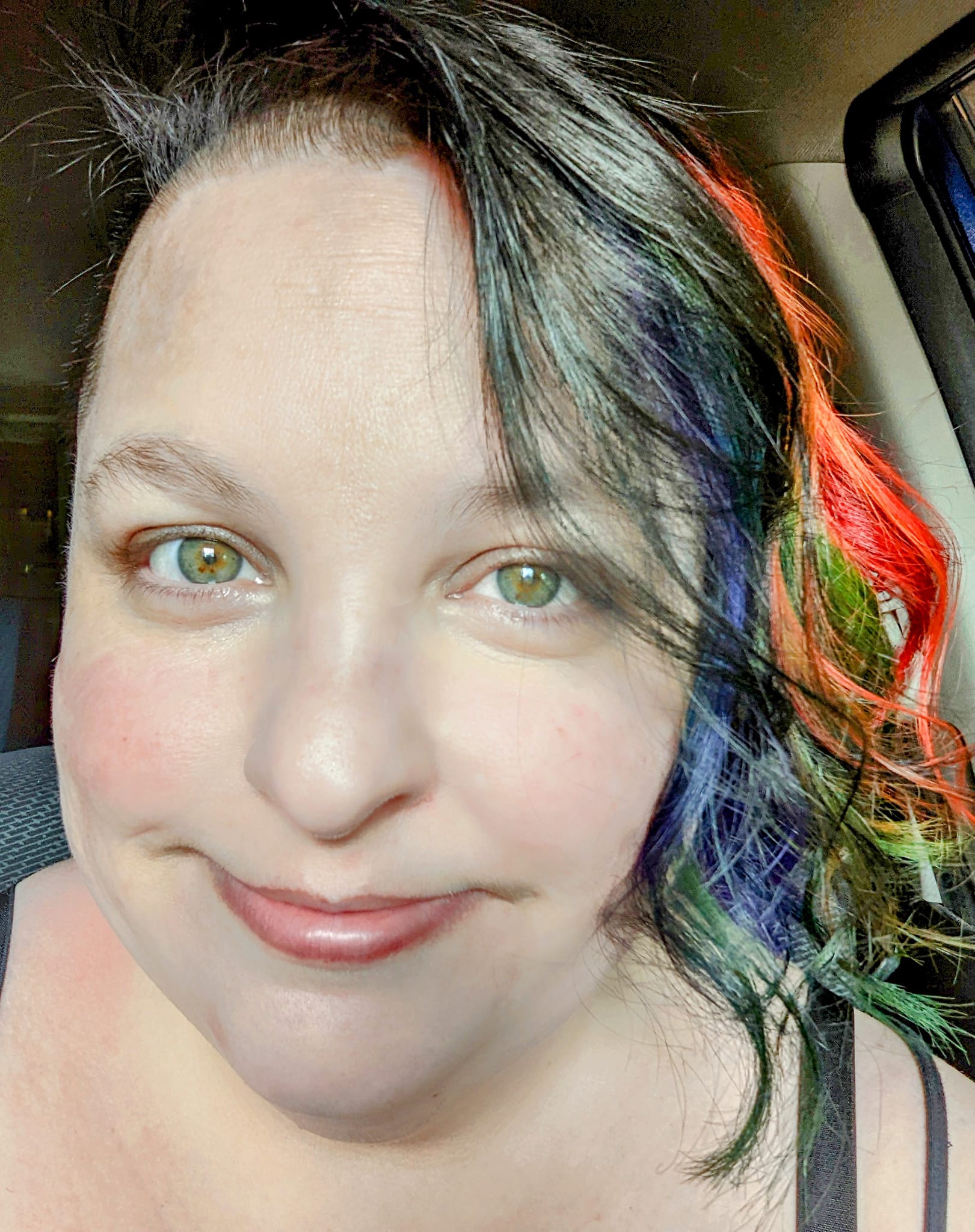The main word I have today is WOW. Also, COLOR. All the colors.
Yesterday, I had “Eye Surgery #1,” which removed the white cataract in my left eye and restored my sight. (Right eye aka surgery #2 will come in late November.) When I tell people that for the last year, I’ve been blind in one eye, they don’t always understand what I mean. I’ve created an image to help you understand.

My left eye was *that* bad. Everything was dark gray with occasional lightness if I stood in front of a lamp.
MY LEFT EYE
I had what they call a mature, steroid-induced, white cataract. My cataracts come from a lifelong use of corticosteroids and steroids. Most were used to treat my severe allergies and asthma. Some were injections used to treat the birth defect in my spine and a multitude of injuries caused by Sjogren’s, a systemic autoimmune disease that affects the entire body. Sjogren’s also loves to attack the eyes. Genetics sucks. :/
Folks had a lot of questions about the surgery as well as my recovery thus far, so I figured I’d make a post about it. For those who’ve been following along, you can jump ahead two paragraphs as they are a bit of background on why it took a year to get to surgery.
THE LEAD UP
This year, I’ve had a lot of appointments and various eye tests/exams to measure the interior of my eye (to create a new lens) and to ensure the rest of my eye was healthy enough for surgery. Part of the reason it took so long to have the surgery was because my Sjogren’s damaged the muscles of my eyelids, causing damage to my corneas. I had to undergo eyelid surgery in both eyes and then wait for my corneas to heal before we proceeded to cataract removal surgery.
Once cleared for surgery, it was a matter of waiting for my excellent surgeon’s schedule to open up. Because I had an advanced or mature cataract, I was considered a Level 2 surgery, which takes a bit longer, is riskier, and has fewer openings. Luckily, someone cancelled and what was originally going to be a late November surgery, got bumped to yesterday. (YAY!)
SURGERY DAY
After the initial check-in, vitals, labeling the eye being operated on, etc., there’s quite a bit of waiting. In fact, the longest part of the surgery is the lead up. I was offered Vicodin, but since it causes anxiety attacks in me, I passed. They use four different medications to dilate the eye—in fact, it can take up to three days for the eye to contract to normal—so some of the time is spent waiting for the four meds to take effect.
Next, they took me into a second pre-op room with an anesthesiologist who does a quick EKG and vitals check. Then they injected medication just below my eye to paralyze it. This is so they can operate on it without you blinking or moving it. Not a good idea with a surgery like this! To be honest, this was the part I was most nervous about. I figured the needle would hurt like hell or at least would be terrifying. I mean, needles + eyes = the stuff of nightmares.
Oddly enough, it didn’t hurt more than a tiny, tiny pinch, followed by some pressure like bad sinus pressure. That only lasted for the two minutes it took for the medication to be injected (they have to go really slow or the pressure will hurt). After ensuring I couldn’t blink or move my eye, they taped my eyelid shut so it wouldn’t dry out, and I was escorted to another waiting area where they checked my vitals for a third and final time.
THE SURGERY
The surgical suite was typical but the chair was a nice, cushy recliner. It was freezing in the room, which made me glad they’d warned me to wear warm clothes. (I chose a long-sleeve Doctor Who shirt, sweatpants, thick socks, and sneakers, and yes, I had several comments from nurses on my Whovian-wear.) They draped a tent-like structure across my face that allows two openings—one over the eye being operated on and a small slit to breathe through. From underneath the tent, you can’t see anything out of your good eye either, so that helps if you don’t like needles. I found it a bit annoying not be able to see, but never fear! They sent me home with a DVD of my surgery.
The procedure itself was really fascinating. I already knew from pre-op appointments that they would use lasers and suction to remove the old lens and the attached cataract. They would replace the old lens with a new, artificial one that would also correct any bad vision issues, astigmatism, etc. It’s like cataract removal + Lasik all in one. They have the ability to correct all vision issues and remove the need for bi or even trifocals, but due to my Sjogren’s, I was only getting my near-sightedness fixed. Oh darn! I’ll still have to wear reading glasses! 😉
They used a device to hold open my eyelids while they worked, which felt cold. The surgeon was surprised I could feel it, but it wasn’t uncomfortable or painful. Just…odd. I could hear but not feel the laser as it removed the cataract and lens. What was weird though was how my vision went from a field of dark gray to sudden white once the bulk of the cataract was gone. The overhead light the surgeon used was like a bright lightbulb in my left eye.
While the eye’s under anesthesia, it’s not only paralyzed, but it’s also supposed to be blind. For whatever reason, I had a sliver of sight towards the bottom of my eye, so when the surgeon inserted the new lens, I could tell. He was moving it around to center it and place it correctly. It was like an odd sense of vertigo as my vision swam. Everything I could see out of that eye moved with the lens. My brain had trouble piecing together what I was seeing. Once he had the new lens in place, my stomach stopped turning, as did my vision.
Then it was done! They taped my eyelid shut and sent me home. It took 10 minutes in the surgical suite to restore my full vision.
Six hours later, my eye was awake enough to remove the tape. Everything was still a bit blurry and dilated, so I mostly rested, napped, and listened to TV. But this morning was an entirely different scenario…
ONE DAY LATER
When I walked into the living room, the first thing I said was, “Erik, is the sky normally that blue?” I blurted it out without thinking because everything looked super-saturated and colorful in ways I didn’t remember. (Makes me wonder how long I’ve had this cataract.) Apparently, this is common.
In comparison to my new left lens, I can tell how fast my right eye is going. There’s a gray haze over everything I see from that eye, which is how the left eye began. But wow, the vision from my left eye is amazing. I’ve spent most of today looking at everything inside and outside with a new appreciation.
I had no idea the house down the street was green and not gray. I didn’t know the stop sign was that shade of red. I’d forgotten.
When I mentioned this to my doctor at my 1 day follow-up appointment, he said, “Welcome to real colors! These are what they’re supposed to look like!”
Wow. Colors. Just wow.
The artist in me can’t wait until my right eye is done!



